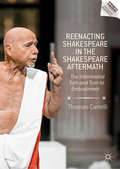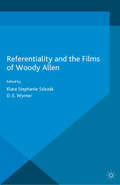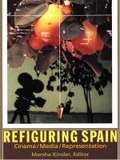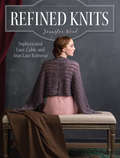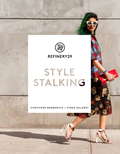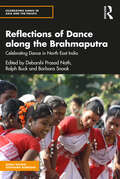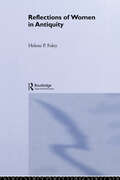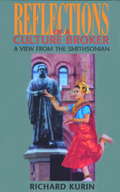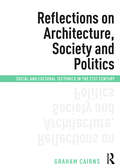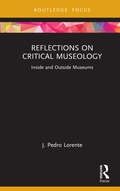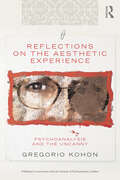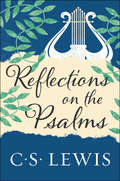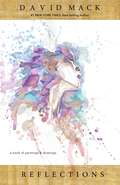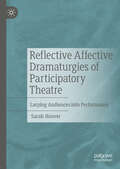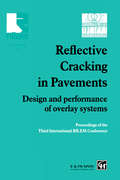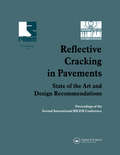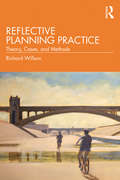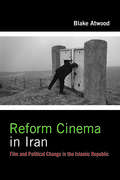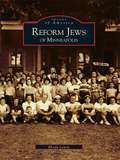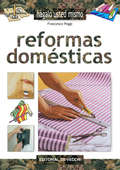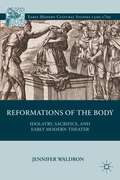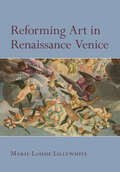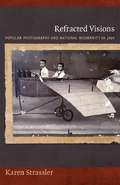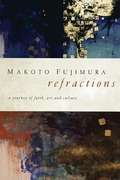- Table View
- List View
Reenacting Shakespeare in the Shakespeare Aftermath: The Intermedial Turn and Turn to Embodiment (Reproducing Shakespeare)
by Thomas CartelliIn the Shakespeare aftermath—where all things Shakespearean are available for reassembly and reenactment—experimental transactions with Shakespeare become consequential events in their own right, informed by technologies of performance and display that defy conventional staging and filmic practices. Reenactment signifies here both an undoing and a redoing, above all a doing differently of what otherwise continues to be enacted as the same. Rooted in the modernist avant-garde, this revisionary approach to models of the past is advanced by theater artists and filmmakers whose number includes Romeo Castellucci, Annie Dorsen, Peter Greenaway, Thomas Ostermeier, Ivo van Hove, and New York’s Wooster Group, among others. Although the intermedial turn taken by such artists heralds a virtual future, this book demonstrates that embodiment—in more diverse forms than ever before—continues to exert expressive force in Shakespearean reproduction’s turning world.
Referentiality and the Films of Woody Allen
by D. E. WynterReferentiality and the Films of Woody Allen is a scholarly collection that provides expansive exploration of the auteur's use of intertexuality, referentiality, and fusion of media forms. Its scope is framed by Allen's intermedial phase beginning in 1983 with Zelig and his most recent film.
Refiguring Spain: Cinema/Media/Representation
by Marsha KinderIn Refiguring Spain, Marsha Kinder has gathered a collection of new essays that explore the central role played by film, television, newspapers, and art museums in redefining Spain's national/cultural identity and its position in the world economy during the post-Franco era. By emphasizing issues of historical recuperation, gender and sexuality, and the marketing of Spain's peaceful political transformation, the contributors demonstrate that Spanish cinema and other forms of Spanish media culture created new national stereotypes and strengthened the nation's place in the global market and on the global stage.These essays consider a diverse array of texts, ranging from recent films by Almodóvar, Saura, Erice, Miró, Bigas Luna, Gutiérrez Aragón, and Eloy de la Iglesia to media coverage of the 1993 elections. Francoist cinema and other popular media are examined in light of strategies used to redefine Spain's cultural identity. The importance of the documentary, the appropriation of Hollywood film, and the significance of gender and sexuality in Spanish cinema are also discussed, as is the discourse of the Spanish media star--whether involving film celebrities like Rita Hayworth and Antonio Banderas or historical figures such as Cervantes. The volume concludes with an investigation of larger issues of government policy in relation to film and media, including a discussion of the financing of Spanish cinema and an exploration of the political dynamics of regional television and art museums. Drawing on a wide range of critical discourses, including feminist, postcolonial, and queer theory, political economy, cultural history, and museum studies, Refiguring Spain is the first comprehensive anthology on Spanish cinema in the English language.Contributors. Peter Besas, Marvin D'Lugo, Selma Reuben Holo, Dona M. Kercher, Marsha Kinder, Jaume Martí-Olivella, Richard Maxwell, Hilary L. Neroni, Paul Julian Smith, Roland B. Tolentino, Stephen Tropiano, Kathleen M. Vernon, Iñaki Zabaleta
Refiguring the Spiritual: Beuys, Barney, Turrell, Goldsworthy (Religion, Culture, and Public Life #9)
by Mark C. TaylorMark C. Taylor provocatively claims that contemporary art has lost its way. With the art market now mirroring the art of finance, many artists create works solely for the purpose of luring investors and inspiring trade among hedge funds and private equity firms. When art is commodified, corporatized, and financialized, it loses its critical edge and is transformed into a financial instrument calculated to maximize profitable returns.Joseph Beuys, Matthew Barney, James Turrell, and Andy Goldsworthy are artists who differ in style, yet they all defy the trends that have diminished art's potential in recent decades. They understand that art is a transformative practice drawing inspiration directly and indirectly from ancient and modern, Eastern and Western forms of spirituality. For Beuys, anthroposophy, alchemy, and shamanism drive his multimedia presentations; for Barney and Goldsworthy, Celtic mythology informs their art; and for Turrell, Quakerism and Hopi myth and ritual shape his vision.Eluding traditional genres and classifications, these artists combine spiritually inspired styles and techniques with material reality, creating works that resist merging space into cyberspace in a way that overwhelms local contexts with global networks. Their art reminds us of life's irreducible materiality and humanity's inescapability of place. For them, art is more than just an object or process—it is a vehicle transforming human awareness through actions echoing religious ritual. By lingering over the extraordinary work of Beuys, Barney, Turrell, and Goldsworthy, Taylor not only creates a novel and personal encounter with their art but also opens a new understanding of overlooked spiritual dimensions in our era.
Refined Knits: Sophisticated Lace, Cable, and Aran Lace Knitwear
by Jennifer WoodElegance at the tip of your needles!Cables and lace are special enough by themselves, but there is something graceful, even magical, about combining the two. Refined Knits concentrates on these two techniques, along with incredibly unique Aran Lace which combines the two, and the results are sure to impress.Enduring Cables: discover cable-work with interesting structure in its detailsGraceful Lace: explore the delicate sophistication of open-workElegant Aran Lace: combine lace and cables in unexpected and stunning waysKnitwear designer Jennifer guides you through knitting these timeless, classic techniques, resulting in finished garments and accessories with a decidedly modern feel you'll treasure for years to come.
Refinery29
by Christene Barberich Piera GelardiTHE COOLEST STREET STYLE CAPTURED BY REFINERY 29 Get set to build your best ever wardrobe featuring the hardest-working looks from around the globe with Refinery29--the world's leading style destination--as their editors break down the essentials of the everyday chic, straight from the street. What transforms a look from on-trend to trendsetting? Editor-in-Chief Christene Barberich and Executive Creative Director Piera Gelardi deconstruct their favorite outfits to reveal what trailblazing looks like on the real-life fashion front, including: * HOW TO WEAR modern metallics, mixed prints, everyday ladylike, tomboy chic, lots of layers, and more. * CLEVER TIPS such as wearing one piece in three fresh ways, building blocks for discovering your own signature style, and updating your closet each season. * AND A ZOOM LENS on all the details and accessories that totally make the look. Featuring the fashion world's coolest tastemakers, designers, stylists, and editors, these fearless iconoclasts challenge conventions and inspire a whole new generation of women to dress for themselves and discover their true inner style stars...just like YOU. From the Trade Paperback edition.
Reflections of Dance along the Brahmaputra: Celebrating Dance in North East India (Celebrating Dance in Asia and the Pacific)
by Debarshi Prasad Nath, Ralph Buck, and Barbara SnookThis volume brings a critical lens to dance and culture within North East India. Through case studies, first-hand accounts, and interviews, it explores unique folk dances of Indigenous communities of North East India that reflect diverse journeys, lifestyles, and connections within their ethnic groups, marking almost every ritual and festival. Dance for people of North East India, as elsewhere, is also a way of declaring, establishing, celebrating, and asserting humans' relationship with nature. The book draws attention to the origins and special circumstances of dances from North East India. It discusses a range of important folk-dance forms alongside classical dance forms in North East India, with a focus on Sattriya dance. The chapters examine how these dance forms play an important role in the region’s socio-cultural, economic, and political life, intertwining religion and the arts through music, dance, and drama. Further, they also explore how folk dance cultures in North East India have never been relegated to the background, never considered secondary, aesthetically, or otherwise, but have become expressions of political and cultural identity. An evocative work, this volume will be of interest to students and researchers of pedagogy, choreography, community dance practice, theatre and performance studies, social and cultural studies, aesthetics, interdisciplinary arts, and more. It will be an invaluable resource for artists and practitioners working in dance schools and communities.
Reflections of Women in Antiquity
by Helene P. FoleyPublished in the year 1981, Reflections of Women in Antiquity is a valuable contribution to the field of Performance.
Reflections of a Culture Broker
by Richard KurinIs culture brokered like stocks, real estate, or marriage? In this engaging book, Richard Kurin shows that cultures are also mediated and indeed brokered by countries, organizations, communities, and individuals -- all with their own vision of the truth and varying abilities to impose it on others. Drawing on his diverse experiences in producing exhibitions and public programs, Kurin challenges culture brokers -- defined broadly to include museum professionals, film-makers, journalists, festival producers, and scholars of many disciplines -- to reveal more clearly the nature of their interpretations, to envision the ways in which their messages can "play" to different audiences, and to better understand the relationship between knowledge, art, politics, and entertainment. The book documents a variety of cases in which the Smithsonian has brokered culture for the American public: a planned exhibit on Jerusalem had to balance both Israeli and Palestinian agendas; debates over the 1996 Olympic Arts Festival presented differing visions of the American South; and the National Air and Space Museum's controversial display of the Enola Gay prompted the Smithsonian to re-examine the role of national museums. Arguing that cultural exhibits reflect a series of decisions about representing someone, someplace, and something, Reflections of a Culture Broker discusses the ethical and technical problems faced by not only those who practice in a museum setting but also anyone charged with representing culture in a public forum.
Reflections on Architecture, Society and Politics: Social and Cultural Tectonics in the 21st Century
by Graham CairnsReflections on Architecture, Society and Politics brings together a series of thirteen interview-articles by Graham Cairns in collaboration with some of the most prominent polemic thinkers and critical practitioners from the fields of architecture and the social sciences, including Noam Chomsky, Peggy Deamer, Robert A.M. Stern, Daniel Libeskind and Kenneth Frampton. Each chapter explores the relationship between architecture and socio-political issues through discussion of architectural theories and projects, citing specific issues and themes that have led to, and will shape, the various aspects of the current and future built environment. Ranging from Chomsky’s examination of the US–Mexico border as the architecture of oppression to Robert A.M. Stern’s defence of projects for the Disney corporation and George W. Bush, this book places politics at the center of issues within contemporary architecture.
Reflections on Critical Museology: Inside and Outside Museums (Museums in Focus)
by J. Pedro LorenteReflections on Critical Museology: Inside and Outside Museums offers a reflective and reflexive re-assessment of museum studies and the first wide-ranging account of critical museology. Drawing on an extensive range of examples from museums and across the museological literature, which are purposefully representative of very different cultural backgrounds, the book issues a plea for critical thinking in and about museums. The various institutions covered and the plural analytical standpoints offer a broad interdisciplinary approach by intermingling art history, anthropology, sociocultural theories and heritage studies. The result is not claimed as a universal or all-encompassing account but a subjective review produced by J. Pedro Lorente, an art critic and historian who has been writing extensively about ‘critical museology’ in different languages for many years. Lorente offers a fascinating synopsis of his ideas in this extremely valuable short book, looking inside and outside museums, combining practice and theory, whilst also relating both to the work of museum professionals and to a range of publications by academics, including those from other research fields. Reflections on Critical Museology: Inside and Outside Museums will be essential reading for university students and academics working in museum studies and cognate disciplines, such as art history, anthropology and cultural studies.
Reflections on the Aesthetic Experience: Psychoanalysis and the uncanny (The New Library of Psychoanalysis 'Beyond the Couch' Series)
by Gregorio KohonInterest in the relationship between psychoanalysis and art - and other disciplines - is growing. In his new book Reflections on the Aesthetic: Psychoanalysis and the uncanny, Gregorio Kohon examines and reflects upon psychoanalytic understandings of estrangement, the Freudian notions of the uncanny and Nachträglichkeit, exploring how these are evoked in works of literature and art, and are present in our response to such works. Kohon provides close readings of and insights into the works of Franz Kafka, Jorge Luis Borges, Louise Bourgeois, Juan Muñoz, Anish Kapoor, Richard Serra, Edvard Munch, Kurt Schwitters, amongst others; the book also includes a chapter on the Warsaw Ghetto Monument and the counter-monument aesthetic movement in post-war Germany. Kohon shows how some works of art and literature represent something that otherwise eludes representation, and how psychoanalysis and the aesthetic share the task of making a representation of the unrepresentable. Reflections on the Aesthetic is not an exercise in "applied" psychoanalysis; psychoanalysis and art are considered by the author in their own terms, allowing a new understanding of the aesthetic to emerge. Kohon’s book makes compelling reading for psychoanalysts, psychotherapists, art therapists, literary and art critics, academics, students and all those interested in the matter of the aesthetic.
Reflections on the Psalms: The Pilgrim's Regress / Prayer: Letter To Malcolm / Reflections On The Psalms / Till We Have Faces / The Abolition Of Man
by C. S. LewisA repackaged edition of the revered author’s moving theological work in which he considers the most poetic portions from Scripture and what they tell us about God, the Bible, and faith.In this wise and enlightening book, C. S. Lewis—the great British writer, scholar, lay theologian, broadcaster, Christian apologist, and bestselling author of Mere Christianity, The Screwtape Letters, The Great Divorce, The Chronicles of Narnia, and many other beloved classics—examines the Psalms. As Lewis divines the meaning behind these timeless poetic verses, he makes clear their significance in our daily lives, and reminds us of their power to illuminate moments of grace.
Reflections: A Book of Paintings & Drawings
by David MackDavid Mack is the New York Times best-selling author and artist of the Kabuki graphic novels, the writer and artist of Daredevil from Marvel Comics, and the author and artist of his children's book The Shy Creatures from MacMillan. Mack most recently created the art & concept for the credit sequence on the #1 hit motion-picture, Captain America: The Winter Soldier. Reflections presents a selection of David Mack's art, including sketches, finished paintings, sculptures, and other various forms, giving the reader a gorgeous look at his creative process.
Reflective Affective Dramaturgies of Participatory Theatre: Larping Audiences into Performance
by Sarah HooverAs the popularity and diversity of participatory theatre productions increase, scholarly and artistic attention toward the audience as agentive contributors and interpreters must keep pace. Simultaneously, the COVID-19 pandemic has added urgency to the collective artistic encounter and its value to individual and community health. This book proposes “reflective affective” dramaturgies of participatory theatre aimed toward incorporating participants’ reflections and affective responses as material in an emergent exploration of represented systems of power. The volume's interdisciplinary theoretical frameworks stem from performance studies discourses including feminist materialism, phenomenology and affect theory, bringing them together with larp scholarship on character/self performance, agency and emergence. Through its integration of the practical and theoretical, this work serves as an essential study for scholars, students and artists in theatre studies, performance studies, visual art studies, role-play studies, cultural studies, and philosophy.
Reflective Cracking in Pavements: Design and performance of overlay systems
by L. Francken E. Beuving A.A.A. MolenaarProceedings of RILEM TC-PRC third conference on this subject. Papers from road authorities, engineers, researchers, contractors and manufacturers discussing the implementation and the long term behaviour of overlay systems. The following topics are covered: prevention and cracking assessment, choice and design of overlay systems, practical implemen
Reflective Cracking in Pavements: State of the Art and Design Recommendations
by J. M. Rigo L. FranckenThis book forms the Proceedings of the Second International RILEM Conference held in Liege in March 1993. It follows the successful first conference held in 1989 and focusses on two main topics: the current state of the art of reflective cracking in highway and other pavements, and design recommendations for field applications. As well as more than 50 international contributions on individual projects, a series of keynote papers are included.
Reflective Planning Practice: Theory, Cases, and Methods
by Richard WillsonReflective Planning Practice: Theory, Cases, and Methods uses structured, first-person reflection to reveal the artistry of planning practice. The value of professional reflection is widely recognized, but there is a difference between acknowledging it and doing it. This book takes up that challenge, providing planners’ reflections on past practice as well as prompts for reflecting in the midst of planning episodes. It explains a reflection framework and employs it in seven case studies written by planning educators who also practice. The cases reveal practical judgments made during the planning episode and takeaways for practice, as the planners used logic and emotion, and applied convention and invention. The practical judgments are explained from the perspective of the authors’ personal experiences, purposes, and professional style, and their interpretation of the rich context that underpins the cases including theories, sociopolitical aspects, workplace setting, and roles. The book seeks to awaken students and practitioners to the opportunities of a pragmatic, reflective approach to planning practice.
Reform Cinema in Iran: Film and Political Change in the Islamic Republic (Film and Culture Series)
by Blake AtwoodIt is nearly impossible to separate contemporary Iranian cinema from the Islamic revolution that transformed film production in the country in the late 1970s. As the aims of the revolution shifted and hardened once Khomeini took power and as an eight-year war with Iraq dragged on, Iranian filmmakers confronted new restrictions. In the 1990s, however, the Reformist Movement, led by Mohammad Khatami, and the film industry, developed an unlikely partnership that moved audiences away from revolutionary ideas and toward a discourse of reform. In Reform Cinema in Iran, Blake Atwood examines how new industrial and aesthetic practices created a distinct cultural and political style in Iranian film between 1989 and 2007. Atwood analyzes a range of popular, art, and documentary films. He provides new readings of internationally recognized films such as Abbas Kiarostami's Taste of Cherry (1997) and Mohsen Makhmalbaf's Time for Love (1990), as well as those by Rakhshan Bani, Masud Kiami, and other key Iranian directors. At the same time, he also considers how filmmakers and the film industry were affected by larger political and religious trends that took shape during Mohammad Khatami's presidency (1997-2005). Atwood analyzes political speeches, religious sermons, and newspaper editorials and pays close attention to technological developments, particularly the rise of video, to determine their role in democratizing filmmaking and realizing the goals of political reform. He concludes with a look at the legacy of reform cinema, including films produced under Mahmoud Ahmadinejad, whose neoconservative discourse rejected the policies of reform that preceded him.
Reform Jews of Minneapolis (Images of America)
by Rhoda LewinThe German Jews who began coming to Minneapolis in the 1850s quickly entered society as doctors, lawyers, professors, merchants, and leaders in clothing and cigar manufacturing. In 1878 they founded Shaarai Tov, now Temple Israel--one of the ten largest Reform congregations in the U.S. today. They also enjoyed a busy social and cultural life, and both husbands and wives involved themselves in social service and welfare organizations. Including historic and present-day photographs and tales of the community--schools, synagogues, organizations, and outdoor activities--this collection uncovers the challenges and triumphs of Reform Jews in Minneapolis.
Reformas domésticas
by Francesco Poggi* Renovar uno mismo su propia casa no es una tarea imposible, si se siguen con atención las indicaciones de este libro. * Pintar las paredes, empapelar, efectuar revestimientos con madera, tapizar con moqueta, colocar el parqué, embaldosar y mil tareas más no tendrán secretos con las detalladas explicaciones y las ilustraciones didácticas que llenan las páginas de esta obra. * Así, podrá decir por fin adiós a las facturas astronómicas de los pintores y tapiceros, y tendrá la satisfacción de un trabajo realizado con esmero.
Reformations Of The Body
by Jennifer WaldronThis project takes the human body and the bodily senses as joints that articulate new kinds of connections between church and theatre and overturns a longstanding notion about theatrical phenomenology in this period.
Reforming Art in Renaissance Venice
by Marie-Louise LillywhiteThe spiritual turmoil of the sixteenth century had a profound impact on religious life throughout Italy. Art and architecture were directly implicated in the seismic historical events of the age, as the Catholic Church countered Protestant iconoclasm through the embrace of sacred images as decreed by the Council of Trent in 1563. In this volume, Marie-Louise Lillywhite considers the impact of religious reform on the devotional art and architecture of sixteenth-century Venice. Interrogating early modern censorship, artistic liberty, notions of decorum tied to depictions of the body, and the role of sacred images in the shaping of local identity, she shows how Venice, a crossroads city exposed to a rich gamut of religious and artistic currents, serves as a fascinating case study through which to explore these themes. Her study reconstructs the conditions that enabled artistic invention to prevail and how artists became interpreters of spiritual values.
Refracted Visions: Popular Photography and National Modernity in Java
by Karen StrasslerA young couple poses before a painted backdrop depicting a modern building set in a volcanic landscape; a college student grabs his camera as he heads to a political demonstration; a man poses stiffly for his identity photograph; amateur photographers look for picturesque images in a rural village; an old woman leafs through a family album. In Refracted Visions, Karen Strassler argues that popular photographic practices such as these have played a crucial role in the making of modern national subjects in postcolonial Java. Contending that photographic genres cultivate distinctive ways of seeing and positioning oneself and others within the affective, ideological, and temporal location of Indonesia, she examines genres ranging from state identification photos to pictures documenting family rituals. Oriented to projects of selfhood, memory, and social affiliation, popular photographs recast national iconographies in an intimate register. They convey the longings of Indonesian national modernity: nostalgia for rural idylls and "tradition," desires for the trappings of modernity and affluence, dreams of historical agency, and hopes for political authenticity. Yet photography also brings people into contact with ideas and images that transcend and at times undermine a strictly national frame. Photography's primary practitioners in the postcolonial era have been Chinese Indonesians. Acting as cultural brokers who translate global and colonial imageries into national idioms, these members of a transnational minority have helped shape the visual contours of Indonesian belonging even as their own place within the nation remains tenuous. Refracted Visions illuminates the ways that everyday photographic practices generate visual habits that in turn give rise to political subjects and communities.
Refractions: A Journey Of Faith, Art, And Culture
by Makoto FujimuraA collection of essays, thoughts, and prayers from award-winning artist Makoto Fujimura, Refractions brings people of all backgrounds together in conversation and meditation on culture, art, and humanity.
